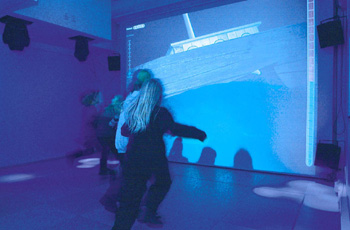
|
|
ERCIM News No.46, July 2001 [contents]
|
by Veli-Pekka Räty
VTT Information Technology is developing user interfaces with which people interact with movements, gestures and touches — instead of conventional computer controls. An example of VTT’s latest innovations is an interface for computer games. The interface, developed in the Lumetila (Virtual Space—User Interfaces of the Future) project, replaces conventional keyboards, mice and joysticks with person’s body movements in interacting with the computer game and with other players.
Today, games use the same controls as word processing, spreadsheet, database or Internet surfing. The recent development of computer game controllers is trying to take advantage from force feedback joysticks and steering wheels. However, these solutions still rely on the old way of controlling the game by using mainly one’s hands and fingers. Also, the player is alone in front of his computer.
Players Share Experiences
In fact, the novel bodily and spatial interface is in a room where the body movements of the players are recognised by pressure sensitive sensors installed in the floor. From the sensors the information is transmitted to the computer, which processes the information and shows the game graphics on the large screen.
The room is also equipped with a surround sound system and light effect devices. These special effect devices and a real time 3D graphics engine together with the team play are essential in creating the immersion and experience in the Virtual Space. The fact, that the players need not wear any virtual reality devices, like data glasses or gloves, helps in creating a total immersion and enables the players to work as a team. The boundaries between the physical space and the interactive virtual space that is presented to the players has thus been weakened. This results in an interactive natural environment with shared experiences between the players.
Nautilus — a Submarine Adventure
For testing the Lumetila concept VTT Information Technology created a game, the LumePong, based on the well-known Pong game from the early 1970s. The test results and experiences were used in developing, planning and designing a new game called Nautilus.
With Nautilus a group of players can make a virtual trip into the underwater world. Their task is to rescue a dolphin that is trapped in a ship wreck. Along the journey to the wreck the team gets score points when collecting star fish and sea horses. Also, there may be dangers under water.
 |
| A group of school children steering the diving bell Nautilus. |
The game is based on cooperation of a group of 5-8 players. When the group goes to the right the submarine turns to the right. If the group steps towards the front edge of the room the speed of the vessel increases. As the group moves backwards the speed of the vessel decreases and the vessel reverses. The whole underwater environment can be seen on the screen. Furthermore, strong light and sound effects are used to enhance the immersive experience, for instance in the case of a collision with a shark. In addition to recreation, the trip involves also physical exercise.
With Nautilus the research group has received essential information for developing advanced user interfaces for entertainment applications, for instance those for science centres and theme parks. This technology and knowledge is also useful in other applications at home and at work.
In the Lumetila project VTT Information Technology works in collaboration with the media company Cube Ltd., Nokia Research Center, theme park Tampereen Särkänniemi Ltd. and the University of Lapland. Tekes, the National Technology Agency of Finland cofunds the project.
Focus on User Friendliness
In all its research activities VTT Information Technology focuses on users and their context of usage. From the very beginning and throughout the whole design process the main guidelines are: who are the users, where are they, and what is the nature of their everyday life. In this Human-Centred Design (HDC) approach, feedback from the users is an essential source of information. The HDC approach is also iterative. The current context is only the starting point for design.
VTT has already applied the HDC approach in many Internet services and mobile systems. Lumetila game concept and user interface is an excellent example of comprehensive application of the Human-Centred Design approach.
Links:
Intuitive Environments: http://www.vtt.fi/tte/research/tte5/tte54/
Lumetila: http://www.vtt.fi/tte/projects/lumetila/
Please contact:
Veli-Pekka Räty — VTT Informatio Technology
Tel: +358 3 316 3340
E-mail: Veli-Pekka.Raty@vtt.fi